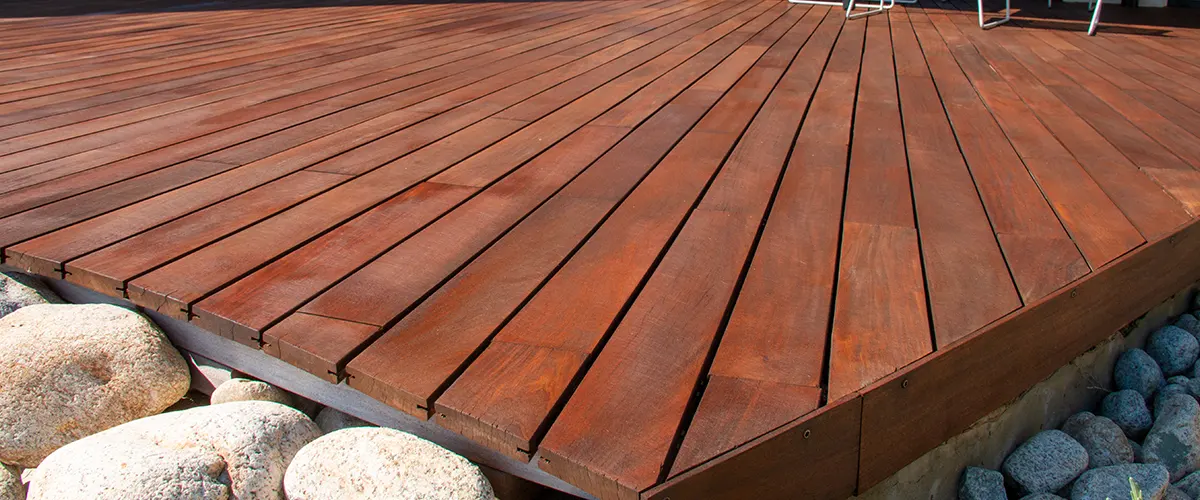
1. What is deck blocking?
2. Why is deck blocking important?
- It strengthens the deck by preventing the joists from twisting or bending.
- It provides additional support for post rails and point loads.
- It increases the deck's lifespan by reducing wear and tear on the deck joists.

3. Benefits of deck blocking
- Decking is more durable and lasts longer than ever before.
- Your deck looks great and provides a smooth, level surface for walking on.
- Deck blocking supports the deck joists, making the deck stronger and less likely to warp or twist.
- Deck blocking helps distribute weight evenly, preventing localized stress points that could lead to deck failure.
4. When is deck blocking necessary?
There are a few circumstances when blocking is necessary. The most commonn instance is when the deck joists are not sized correctly for the span. In this case, blocking can add strength to the deck.
Blocking is also necessary when installing decking over a roof, as it provides extra support for the deck joists. Finally, deck blocking may be required by local building codes.
If you’re unsure whether or not your deck needs blocking, it’s always best to consult with a professional deck builder. They will be able to assess your deck and determine if blocking is necessary.
Building a deck without blocking can result in a weaker outdoor space that is more susceptible to damage. In some cases, it can also void your deck warranty. So if you’re planning on building a deck, be sure to include blocking in your plans.

5. The different types of deck blocking
Full Depth Solid Blocking:
Half-Depth Blocking:
Single Blocking:
Unenclosed Blocking:
End Blocking:
6. Deck blocking spacing

7. How to make sure you have the proper deck joist spacing?
Joist spacing with composite decking
Local building codes

8. Alternatives to deck blocking
According to NADRA, there are a few alternatives to deck blocking, though they may not be as effective. Some homeowners use metal L-brackets screwed into the framing to attach the deck boards.
Others use a construction adhesive to adhere the deck boards to the joists. While these methods may be less effective than deck blocking, they may be more feasible for some homeowners.
9. How to install blocking?

1. Determine the placement of the deck blocking
First, you’ll need to determine the placement of the deck blocking. Deck blocking is typically installed every 16 inches on the center. However, be sure to check your local building codes for the specific requirements in your area.
Once you’ve determined the placement of the deck blocking, mark the location of each block on the joists with a chalk line.
If you’re attaching the deck blocking with screws, predrill each hole with a countersink bit. This will make it easier to drive the screws and prevent the wood from splitting.
2. Cut the deck blocking to size and shape
Next, you’ll need to cut the deck blocking to size. The deck blocking should be about 12 inches long for a standard deck. However, you may need to adjust the length depending on the design of your deck.
Once you’ve cut the deck blocking to size, use a jigsaw to cut each block to shape. If you’re using decking screws, be sure to countersink the holes.
If you’re attaching the deck blocking with nails, use a hammer to drive the nails into the joists. Start at one end of the deck and work your way down.
3. Fasten the deck blocking
4. Install the decking boards over the deck blocking
Start at the outside edge of the deck and work your way in. Use deck screws to attach the deck boards to the blocking. Be sure to predrill all holes to avoid splitting the wood.
It is also a good idea to use washers under the head of each screw. This will help keep the boards from cupping.
When you reach the end of the deck boards, cut them to fit snugly against the deck railing. Use a circular saw to make the cuts.
After installing tall boards, check for any nails that may have popped up and hammer them back down.

10. Tips for a proper deck blocking installation
- Use hurricane ties or similar heavy-duty fasteners to connect the deck joists to the beams and posts.
- Make sure the fasteners are long enough to penetrate through the thickness of the pressure-treated lumber.
- Use a level to ensure the deck joists are level before attaching any additional material to the beams.
- Install deck blocking at regular intervals along the length of the deck joists.
- Use galvanized nails or deck screws to attach the blocking material to the joists.
- Make sure the ends of the deck boards are correctly supported by blocking.
Conclusion
If you’re in the process of building a deck, it’s essential to make sure that you install your joist blocking correctly. This will help keep your framing straight and strong and prevent twisting and sagging over time.
If you need help with your deck installation, don’t hesitate to contact us. We would be happy to walk you through the installation process and answer any questions you may have.
